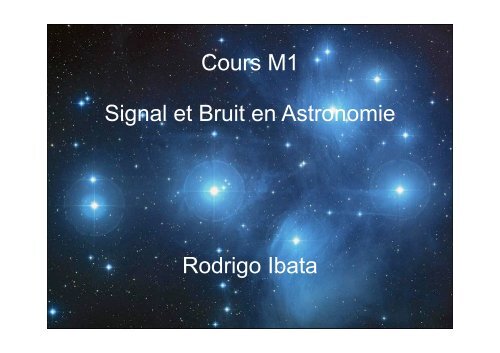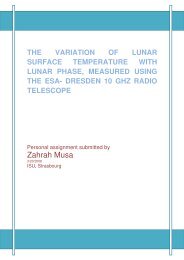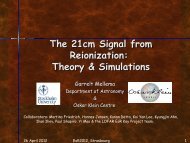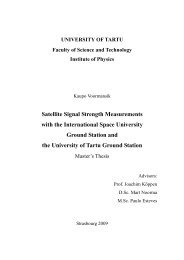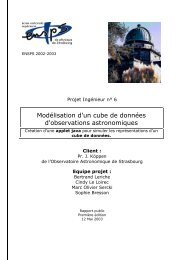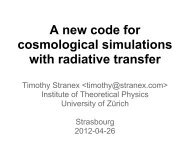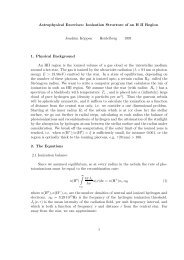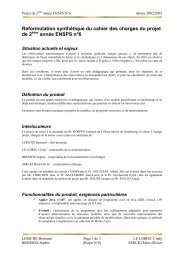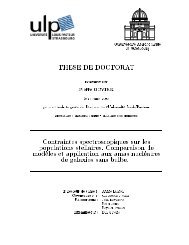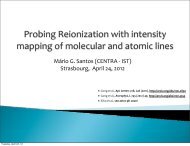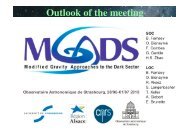Cours M1 Signal et Bruit en Astronomie Rodrigo Ibata - Observatoire
Cours M1 Signal et Bruit en Astronomie Rodrigo Ibata - Observatoire
Cours M1 Signal et Bruit en Astronomie Rodrigo Ibata - Observatoire
Create successful ePaper yourself
Turn your PDF publications into a flip-book with our unique Google optimized e-Paper software.
<strong>Cours</strong> <strong>M1</strong><br />
<strong>Signal</strong> <strong>et</strong> <strong>Bruit</strong> <strong>en</strong> <strong>Astronomie</strong><br />
<strong>Rodrigo</strong> <strong>Ibata</strong>
Date: September 21, 2006Category: Structure and Dynamics of Galaxies Proposal: F1738<br />
CFHT<br />
OBSERVING TIME REQUEST<br />
Semester: 2006A Ag<strong>en</strong>cy: France<br />
demandes de temps télescope...<br />
1. Title of the Program (may be made publicly available for accepted proposals):<br />
The ext<strong>en</strong>ded disks of galaxies: a new galactic compon<strong>en</strong>t?<br />
2. Principal Investigator: <strong>Rodrigo</strong> <strong>Ibata</strong><br />
Postal address: <strong>Observatoire</strong> de Strasbourg, 11, rue de l’Universite, F-67000 Strasbourg, France<br />
Fax: +33 3 90 24 24 32 Phone: +33 3 90 24 23 91E-mail: ibata@astro.u-strasbg.fr<br />
3. Co-Investigators:<br />
Scott Chapman Institute: Caltech E-mail: schapman@astro.caltech.edu<br />
Ann<strong>et</strong>te Ferguson Institute: Royal Observatory Edinburgh E-mail: ferguson@roe.ac.uk<br />
Michael Irwin Institute: Institute of Astronomy, Cmabridge E-mail: mike@ast.cam.ac.uk<br />
Geraint Lewis Institute: University of Sydney E-mail: gfl@physics.usyd.edu.au<br />
Nicolas Martin Institute: <strong>Observatoire</strong> de Strasbourg E-mail: martin@astro.u-strasbg.fr<br />
Mustapha Mouchine Institute: John Moore’s Univeristy, Liverpool E-mail: mm@astro.livjm.ac.uk<br />
Nial Tanvir Institute: University of Hartfordshre E-mail: nrt@ast.cam.ac.uk<br />
4. Summary of the Program (may be made publicly available for accepted proposals):<br />
We propose to use MegaCam to observe M81, the nearest giant spiral galaxy beyond the Local Group, reaching<br />
∼ 2 magnitudes below the red giant branch (RGB) tip to probe the stellar populations beyond the <strong>en</strong>d of the<br />
thin disk. If this galaxy is similar to the Milky Way and M31, we will uncover an inhomog<strong>en</strong>ous,<br />
brightness, ext<strong>en</strong>ded disk-like structure, a previously unknown compon<strong>en</strong><br />
profound implications for our understanding of galaxy f<br />
will be able to interpr<strong>et</strong> the Milky<br />
the requested
demandes de temps télescope...<br />
9. Justification of requested observing time and lunar phase<br />
Lunar Phase Justification: Grey time or bright time is adequate to observe these relatively bright sources.<br />
Time Justification: (including seeing overhead) Using the Version 2.9.4 ETC for FLAMES-GIRAFFE, wh<strong>en</strong><br />
observing the CaII tripl<strong>et</strong> of a template K7V star at I ∼ 16.5 with the HR21 s<strong>et</strong>ting (8484–9001˚A, R=16200),<br />
31 minutes are necessary to reach S/N= 20 in normal observing conditions (seeing 0. ′′ 8; airmass 1.3, 10 days from<br />
new moon). This is suffici<strong>en</strong>t to measure velocities to an accuracy of 2 km/s and d<strong>et</strong>ermine the intrinsic velocity<br />
dispersion of the CMa population as well as derive m<strong>et</strong>allicities from the Ca tripl<strong>et</strong> observations. Including the<br />
overheads, this means that the single MEDUSA configuration requested for eight fields correspond to 0.7 h of<br />
exposure for each field, including the overhead. The three last fields we wish to observe will require a second<br />
MEDUSA configuration, and will therefore need 1.5 h of exposure time.<br />
Thus, the total observation time adds up to 10.0 hours.<br />
alibration
Presque tous les spectrographes...
plus bleu<br />
(spectre “echelle” du Soleil)<br />
plus rouge
Filtre<br />
<strong>et</strong> les cameras...
...utilis<strong>en</strong>t les cameras CCD...
Très efficaces!!!<br />
Les cameras CCD
Les cameras CCD<br />
Puce silicium
Calibration des images CCD<br />
bias<br />
flat
Défauts typiques<br />
Lignes mortes
Défauts des CCDs<br />
Poussière
Rayons cosmiques
Rayons cosmiques
Défauts typiques
Saturation <strong>et</strong> diffraction
“Fringing”
PSF (point spread function)<br />
• PSF idéal est un disque d’Airy:<br />
• Les obstructions dans l’instrum<strong>en</strong>t <strong>et</strong><br />
l’optique r<strong>en</strong>d<strong>en</strong>t la PSF plus complexe<br />
• résolution angulaire:
“Seeing” aux télescopes ESO
Réduction des données CCD<br />
raw = (obj + sky x (1 + fringe)) x QE + dark + flash + bias<br />
Correction for Zero exposure Additive Systematics:<br />
= dark + flash + bias<br />
“Overscan” region to remove DC bias variations:<br />
raw - - (overscn - ) = obj +sky x (1+fringe)) x QE<br />
Correction for Multiplicative Spatial Systematics (flat-fielding):<br />
= QE + dark + flash + bias<br />
const x (raw - ) / ( - ) = obj + sky x (1 + fringe)<br />
Correction for Additive Spatial Systematics:<br />
= sky x (1+fringe)
Définition du système de magnitudes AB:<br />
• Fν(mag=0) = 3631 Jy (pour toutes les ν)<br />
• = 3631 x 10 -26 W / Hz / m 2<br />
• Fλ(mag=0) = 5.48 x 10 6 /(λ[Å]) ph/s/Å/cm 2<br />
• Fλ ≈ 1000 x 10 -0.4 V ph/s/Å/cm 2 (<strong>en</strong> V)
Brillance du ciel (mag arcsec 2 )<br />
U B V R I J H K<br />
Ciel obscur 22.8 22.5 21.5 20.8 19.3<br />
6 nuits 21.3 20.8 20.4 19.2<br />
Pleine<br />
Lune<br />
18.8 18.5 18.9 18.2 13.7 13.7 12.5
Calcul du <strong>Signal</strong> sur <strong>Bruit</strong><br />
• Autres:<br />
– <strong>Bruit</strong> de lecture =<br />
– <strong>Bruit</strong> de “flat-fielding” = facteur x Nsig<br />
– <strong>Bruit</strong> de “fringing” = facteur x Nciel
Exemples:<br />
• Quelle est la magnitude limite de l’oeil<br />
humain? Ou de ma camera numérique?<br />
• Combi<strong>en</strong> de temps faut-il<br />
– pour att<strong>en</strong>dre la magnitude V=25 <strong>en</strong><br />
photométrie avec le VLT?<br />
– pour mesurer les spectres des étoiles rouges<br />
de magnitude I=21 dans la galaxie M31, avec<br />
le télescope Keck, avec une résolution de<br />
R=10000?


